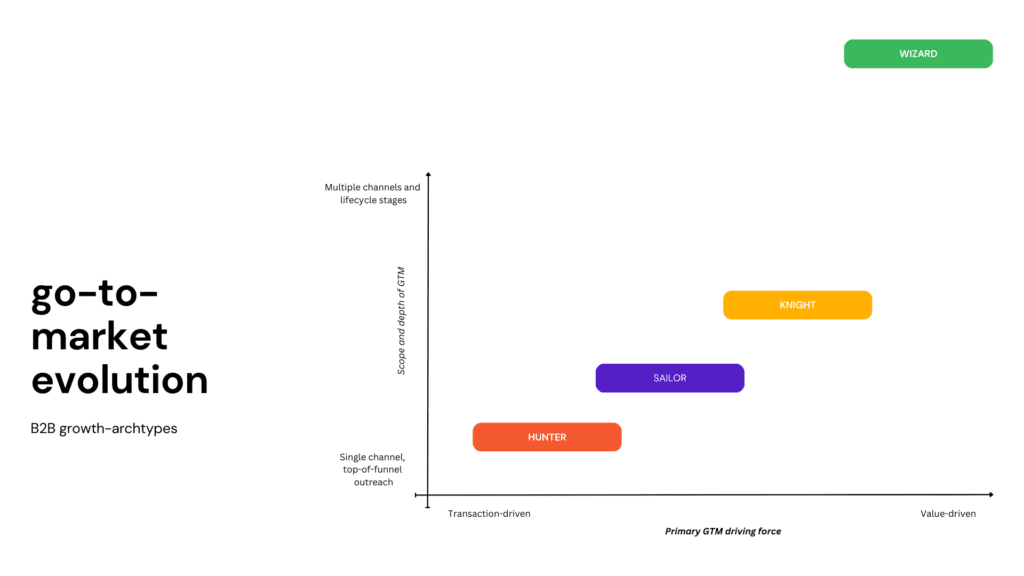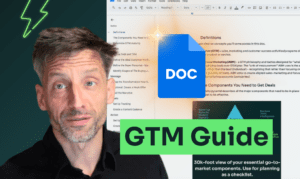Over the years, we have worked with and closely observed multiple B2B companies.
We’re concluded that: On a maturity matrix, the most mature companies are usually the ones actively using multiple channels and targeting buyers throughout an entire lifecycle and the ones that follow a value-driven GTM instead of a transaction-driven one.
When companies start out, they usually follow a single-channel, transaction-driven approach where the CEO/founder is responsible for making calls and closing sales. As companies scale, they add value to their offering and branch out to a few channels. The ultimate goal, however, is to adopt a marketing-led approach instead of a sales-led one.
Where are you on your B2B growth journey?
But somewhere on this matrix, companies get stuck without a clear direction about how to scale marketing. The key to getting out of this dilemma is identifying where you are on the matrix and which level you need to ascend to. Most of these companies fall under one of the following four broad categories according to maturity:
- Hunter: The Hunter is known for being a go-getter. They’re categorized as people with a lot of drive to get things done, but because of the limitation of their skills, often end up taking a “hunting” approach to marketing. The hunting approach implies that while there is activity in the woods, setting out in the morning without direction on what to shoot and how to do it is not the best way to lead. The Hunter’s struggle never ends, for they must set out to hunt every day unless they change their tactics. In this stage, you have a few salespeople and a non-existent marketing department. The only goal here is to sell.
- Sailor: the Sailor is a step up from the Hunter. Unlike the Hunter, the Sailor has both the tools and the know-how to use them. What the Sailor lacks is finesse and control. Their path is highly dependent on the winds and currents, meaning the markets, economy, and other external factors completely dictate what happens to the Sailor. Sailors also use more than one channel and follow a rather polished approach to marketing as opposed to the Hunter.
- Knight: The Knight has more than one way of getting what they want by using sophisticated tools and tactics. The Knight has what the Hunter and Sailor both lack: finesse. The Knight is not focused on selling but instead on establishing relationships with highly influential people, whose influence he leverages to get to his end goal. They do not hunt, nor do they sail, but they do get other people to do that for them.
- Wizard: The Wizard in comparison to the Hunter, Sailor, and Knight is a huge qualitative jump. In fact, the game that the Wizard plays is so different from the rest that they are almost in a league of their own. The Wizard’s tactics are refined and perfected over time and to an untrained eye, this looks like magic. The returns you can expect from your GTM efforts should be exponentially higher than the rest. Here, sales, marketing, and customer success are all consolidated under one revenue department. At this stage, you’re present on a variety of channels and have a full lifecycle sales and marketing outlook along with a value-driven GTM.

Growth Archetypes can help B2B companies determine where they are on their growth journey and how can they ascend to the ultimate stage faster.
These stages reflect not just who you are, but also how you are perceived within a team or the company. The journey of going from an enthusiastic but unrefined Hunter to the Sailor with direction but victim to their circumstances, to a Knight with finesse and direction, and finally ascending to the Wizard stage where implementing your skills almost feels like magic is a long, tough journey. Identifying where you are on this matrix is step 1, and getting a detailed report on how to move forward is step 2. Hence:
Where are you on your B2B growth journey?
FAQs:
- How to go to market?
Going to market requires companies to devise a GTM (go-to-market) plan. This plan should detail your ICP, messaging, positioning, and branding components along with the channels you will use, the strategies and tactics you will implement, research about your competitors, goals, and KPIs your team will be measured on, and more.
2. What does a go to market strategy look like?
A go to market strategy starts out with thorough research and planning. A GTM plan details your ICP, messaging, positioning, and branding components along with the channels you will use, the strategies and tactics you will implement, research about your competitors, goals, and KPIs your team will be measured on, and more.
Related Posts
- Transforming From Sales-led Growth to Marketing-led Growth - ep 38
https://youtu.be/jOKRuhF2gwc At Klear, we’ve been talking a lot about how transitioning from sales-first growth to…
- Systematic B2B Growth Experiments with Tristan Gillen - ep 23
https://youtu.be/A-LKxj4oBI0 Anyone who’s been in marketing long enough knows that marketing doesn’t run on set…
- The simple B2B growth-marketing play - ep 3
Can you have success with almost zero marketing? Some believe it’s possible. Up to a…

